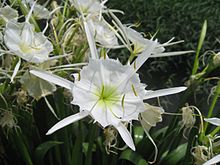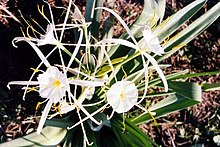Fair skin
| Fair skin | ||||||||||||
|---|---|---|---|---|---|---|---|---|---|---|---|---|

|
||||||||||||
| Systematics | ||||||||||||
|
||||||||||||
| Scientific name | ||||||||||||
| Hymenocallis | ||||||||||||
| Salisb. |
The genus of beautiful skin ( Hymenocallis ), also called beautiful lilies , belongs to the Amaryllis family (Amaryllidaceae). The wide natural range of the 50 to 65 species lies in the Neotropic .
description
Appearance and leaves

Hymenocallis species grow as perennial herbaceous plants . They live as evergreen plants or geophytes and develop onions as persistence organs. The egg-shaped or spherical onions have a tunic (onion skin). There are 2 to 16 leaves formed directly above the bulb , which are rarely stalked. The leaf blades are narrow to broadly tongue-shaped or obscure-lanceolate, rarely ovoid to elliptical.
Inflorescences and flowers
A more or less long, leafless inflorescence stem is formed. Two to three triangular, oval or lance-shaped bracts surround the flowers knopigen protective and hang down in the flower up state. The umbel-shaped inflorescence contains one to 16 mostly sessile, upright or somewhat divergent flowers, each with an often narrow lanceolate bract.
The large, star-shaped, fragrant flowers are radial symmetry and threefold. The six identical bracts are fused at their base to form a more or less long tube. There are six fertile stamens . At Hymenocallis TYPES is particularly striking about the standing of perianth funnel or wheel-shaped corona, which is formed from the overgrown areas of the stamens. The margins of the secondary crown are often toothed or torn. The often long, thread-like, free area of the stamens is bent back or ascending. The pollen is yellow, often gold or orange in color. Three carpels are to one, spherical, ovoid, oblong or pear-shaped, under constant, dreikammerigen ovary grown. Each ovary chamber contains two to ten ovules . The thin stylus ends in a cephalic scar.
Fruits and seeds
The large, green, almost spherical to elongated capsule fruits are triple and leathery. The large seeds are green and fleshy.
Sets of chromosomes
The basic chromosome number is x = 20, 23.
Systematics and distribution
The first description of the genus Hymenocallis was made in 1812 by Richard Anthony Salisbury in Transactions of the Horticultural Society of London , 1, p 338. As lectotype was 1913 Hymenocallis littoralis (Jacq.) Salisb. set. The generic name Hymenocallis is derived from the Greek words hymên for skin and kallos for beautiful, this refers to the flowers. Synonyms for Hymenocallis Salisb. are: Liriopsis Rchb. , Choretis Herb. , Nemepiodon Raf. , Siphotoma Raf. , Tomodon Raf. , Troxistemon Raf.
The genus Hymenocallis belongs to the tribe Hymenocallideae in the subfamily Amaryllidoideae within the family Amaryllidaceae . Some species that were previously classified in the Hymenocallis belong to the closely related genera Ismene Salisb. ex Herb. and Leptochiton Sealy . Some species of the genus Pancratium L. now belong to Hymenocallis .
The neotropical distribution area extends from the southeastern and south-central USA (15 species), over the Caribbean islands and Central America to South America .







The genus Hymenocallis includes 50 to 65 species:
- Hymenocallis acutifolia (Herb. Ex Sims) Sweet : Mexico.
- Hymenocallis araniflora T.M.Howard : It comes in the southern western Mexican states of Sinaloa and Nayarit ago.
- Hymenocallis arenicola Northr. : Caribbean.
- Hymenocallis astrostephana T.M.Howard : Mexican state of Guerrero.
- Hymenocallis azteciana Traub Mexico.
- Hymenocallis baumlii Ravenna : Mexican state of Chiapas.
- Hymenocallis bolivariana grape : Venezuela.
- Hymenocallis caribaea (L.) Herb. : Caribbean.
- Hymenocallis choctawensis Traub Southeastern United States.
- Hymenocallis choretis Hemsl. : Central and Southwestern Mexico.
- Hymenocallis cleo Ravenna : Mexican state of Chiapas.
- Hymenocallis clivorum Laferr. : Mexican state of Sonora.
- Hymenocallis concinna Baker : Mexico.
- Hymenocallis cordifolia Micheli : Mexican state of Guerrero.
- Hymenocallis coronaria (Leconte) Kunth : South Carolina to Alabama.
- Hymenocallis crassifolia Herb. : North Carolina to Georgia.
- Hymenocallis durangoensis T.M.Howard : Mexican state of Durango.
- Hymenocallis duvalensis grape ex Laferr. : Southern Georgia to Northern Florida.
- Hymenocallis eucharidifolia Baker : Mexico.
- Hymenocallis fragrans (Salisb.) Salisb. : Jamaica.
- Hymenocallis franklinensis Ger.L.Sm., LCAnderson & Flory : Northwest Florida.
- Hymenocallis gholsonii G.Lom.Sm. & Garland : Florida.
- Hymenocallis glauca (Zucc.) M. Roem. : Central and Southwestern Mexico.
- Hymenocallis godfreyi G.L.Sm. & Darst : Northwest Florida.
- Hymenocallis graminifolia Greenm. : Mexico (Morelos).
- Hymenocallis guatemalensis grape : Guatemala.
- Hymenocallis guerreroensis T.M. Howard : Mexico (Guerrero).
- Hymenocallis harrisiana Herb. : Central and Southwestern Mexico.
- Hymenocallis henryae grape : Northwest Florida. With two varieties.
- Hymenocallis howardii Bauml : Southwestern Mexico.
- Hymenocallis imperialis T.M. Howard : Mexico.
- Hymenocallis incaica Ravenna : Peru.
- Hymenocallis jaliscensis M.E. Jones : Mexico (Jalisco, Nayarit).
-
Hymenocallis latifolia (Mill.) M. Roem. (Syn .: Chrysiphiala latifolia (Mill.) Ker Gawl. , Pancratium latifolium Mill. , Pancratium caymanense (Herb.) Alain , Pancratium expansum Sims , Hymenocallis expansa (Sims) Herb. , Pancratium patens Delile nom. Illeg., Hymenocallis caymanensis Herb . , Hymenocallis deleuilii auct., Hymenocallis collieri Small , Hymenocallis keyensis Small , Hymenocallis kimballiae Small ): It occurs in Florida and on the Caribbean islands. There are two varieties:
- Hymenocallis latifolia var. Latifolia : Florida to the Caribbean.
- Hymenocallis latifolia var. Puntagordensis (Traub) DBWard (Syn .: hymenocallis puntagordensis Traub ): It comes on in Florida Punta Gorda before.
- Hymenocallis leavenworthii (Standl. & Steyerm.) Bauml : Mexico (Michoacán).
- Hymenocallis lehmilleri T.M.Howard : Mexico (Guerrero).
- Hymenocallis limaensis Traub : Peru.
- Hymenocallis liriosme (Raf.) Shinners : Oklahoma to Alabama.
- Hymenocallis littoralis (Jacq.) Salisb. : It is distributed from Mexico through Central America to northern Peru and Brazil.
- Hymenocallis lobata Klotzsch : Venezuela.
- Hymenocallis longibracteata Hochr. : Mexico (Veracruz).
- Hymenocallis maximiliani T.M. Howard : Mexico (Guerrero).
- Hymenocallis multiflora Vargas : Peru.
- Hymenocallis occidentalis (Leconte) Kunth : Central and southeastern United States. With two varieties.
- Hymenocallis ornata (CDBouché) M. Roem. : Guatemala.
- Hymenocallis ovata (Mill.) Roem, M. : Cuba.
- Hymenocallis palmeri S. Watson : Florida.
- Hymenocallis partita Ravenna : Mexico (Chiapas).
- Hymenocallis phalangidis Bauml : Mexico (Nayarit).
- Hymenocallis pimana Laferr. : Mexico (Chihuahua).
- Hymenocallis portamonetensis Ravenna : Mexico (Chiapas).
- Hymenocallis praticola Britton & P.Wilson : Cuba.
- Hymenocallis proterantha Bauml : Southwestern Mexico.
- Hymenocallis pumila Bauml : Mexico.
- Hymenocallis pygmaea grape : From southeastern North Carolina to northeastern South Carolina.
- Hymenocallis rotata (Ker Gawl.) Herb. : Northern Florida.
- Hymenocallis schizostephana Worsley : Presumably Brazil.
- Hymenocallis sonorensis Standl. : Mexico (Sonora to Nayarit).
- Magnificent fair skin ( Hymenocallis speciosa (L. f. Ex Salisb.) Salisb. ): It occurs only on the Caribbean islands above the wind .
- Hymenocallis tridentata Small : East-central and southern Florida.
- Hymenocallis tubiflora Salisb. : Trinidad to northern Brazil.
- Hymenocallis vasconcelosii García-Mend. : Mexico (Oaxaca).
- Hymenocallis venezuelensis grape : Venezuela.
- Hymenocallis woelfleana T.M.Howard Mexico.
No longer belonging to Hymenocallis , but to the genus Ismene (selection):
- Ismene amancaes (Ruiz & Pav.) Herb. (Syn .: Hymenocallis amancaes (Ruiz & Pav.) G.Nicholson )
- Ismene longipetala (Lindl.) Meerow (Syn .: Hymenocallis longipetala (Lindl.) JFMacbr. )
- Ismene narcissiflora (Jacq.) M. Roem. (Syn .: Hymenocallis narcissiflora > (Jacq.) JFMacbr. )
use
The varieties of some species and hybrids are used as ornamental plants in tropical parks and gardens.
swell
- Gerald L. Smith, Walter S. Flory: Hymenocallis. , P. 283 - the same text online as the printed work , In: Flora of North America Editorial Committee (Ed.): Flora of North America North of Mexico. Volume 26: Magnoliophyta: Liliidae: Liliales and Orchidales , Oxford University Press, New York and Oxford, 2002. ISBN 0-19-515208-5
Individual evidence
- ^ Hymenocallis at Tropicos.org. In: IPCN Chromosome Reports . Missouri Botanical Garden, St. Louis
- ^ Hymenocallis at Tropicos.org. Missouri Botanical Garden, St. Louis, accessed October 19, 2014.
- ↑ a b c d e f g h i j k l m n o p q r s t u v w x y z aa ab ac ad ae af ag ah ai aj ak al am an ao ap aq ar as at au av aw ax ay az ba bb bc bd be bf bg bh bi bj bk bl bm bn bo Rafaël Govaerts (Ed.): Hymenocallis. In: World Checklist of Selected Plant Families (WCSP) - The Board of Trustees of the Royal Botanic Gardens, Kew . Retrieved July 27, 2018.
- ^ Hymenocallis in the Germplasm Resources Information Network (GRIN), USDA , ARS , National Genetic Resources Program. National Germplasm Resources Laboratory, Beltsville, Maryland. Retrieved February 27, 2011.
- ↑ Walter Erhardt, Erich Götz, Nils Bödeker, Siegmund Seybold: The great zander. Encyclopedia of Plant Names. Volume 2. Types and varieties. Eugen Ulmer, Stuttgart (Hohenheim) 2008, ISBN 978-3-8001-5406-7 .
- ↑ Gordon Cheers (Ed.): Botanica. The ABC of plants. 10,000 species in text and images . Könemann Verlagsgesellschaft, 2003, ISBN 3-8331-1600-5 (therein page 460).
